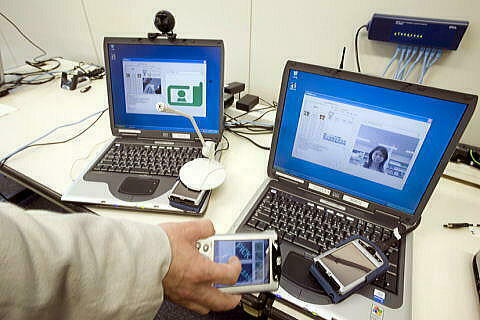 |
[ Japanese Page ] Department of Information and Communications Engineering / Innovative Global Program College of Engineering, Shibaura Institute of Technology |

Cafe counter table in Lab
Research - Towards User-friendly Information and Communication Environment -
The Mobile Multimedia Communications Laboratory has a slogan, "Towards User-friendly Information and Communication Environment." User-friendly Information and Communication Environment refers to an environment where Humans can use information and communication services without being conscious of computers. The concept of not being conscious of computers was proposed by Mark Weiser, known as the father of ubiquitous computing. In this laboratory, we believe that this concept can be realized through human-centric intelligent information and communication systems, conducting research activities from various perspectives.
Human-centric Information and Communication Systems
Human-centric information and communication systems are systems that provide users with the necessary or meaningful information services they need. This enables users to utilize information services with high satisfaction. However, since the necessary or meaningful information differs for each individual user, hence, customized services for each user are required. To address this challenge, context-aware systems, and intelligent information communication systems are essential.Context-Aware Systems
Context refers to all the information surrounding the user. For example, it includes time, location, brightness, temperature, humidity, schedule, devices being used, people present, user profiles, and so on. Context-aware systems utilize the Internet of Things (IoT) and Artificial Intelligence (AI) technologies to automatically detect and acquire information surrounding the user, and accurately predict the user's current situation.
Intelligent Information Communication Systems
Intelligent information communication systems utilize Artificial Intelligence (AI) technologies to accurately predict and decide the necessary or meaningful information for the users based on their current situation. These systems provide the information to users at the appropriate timing by suitable methods.
Main Research Topics
To achieve the slogan, "Towards User-friendly Information and Communication Environment," we are conducting the following research:- Information and Communication Applications using Artificial Intelligence Technology.
- Estimation of User Characteristics and Emotions using Biometric Information
- User-friendly Intuitive User-interfaces.
- Comfortable Intelligent Information Environment using Sensibility.
- Quality of Information and Communication Services with High Satisfaction.
- High-quality acoustic environments Aiming for Faithful Reproduction of Original Sounds.
- Support Systems for Disabled People using IoT Technologies
- Media Technologies to Achieve Audiovisual Presence.
- Emotion Estimation using SNS Information
- Remote Learning Support System Considering User's Level of Understanding
 |
 |
 |
| Multimedia Communication Control System | Vibration-based Communication System | Walking Assistance for the Visually Impaired |
| With a small device like a smartphone, you can simply click to transfer only video, only audio, or both to other multimedia playback devices. | When you place smartphones A and B on a table, the vibrations emitted by A travel through the table to reach B, and data is transferred at the same time. | When visually impaired individuals walk, obstacles are detected by ultrasonic sensors attached to their visors to support their walking. |